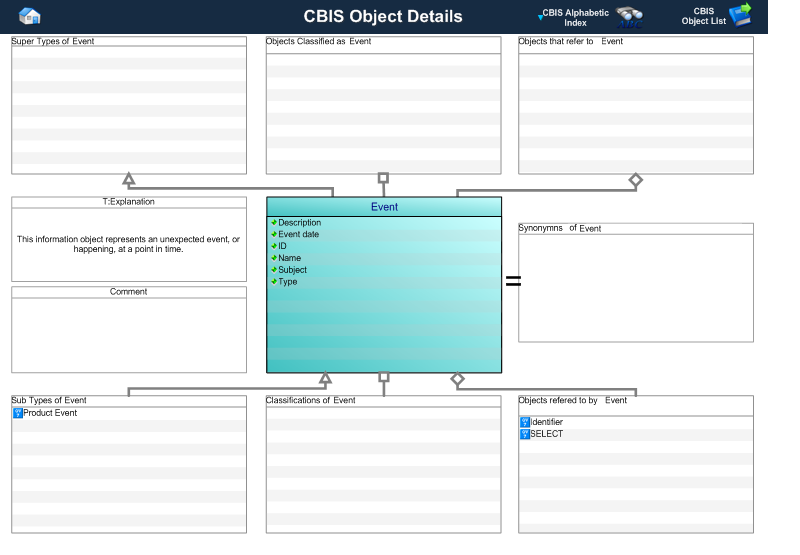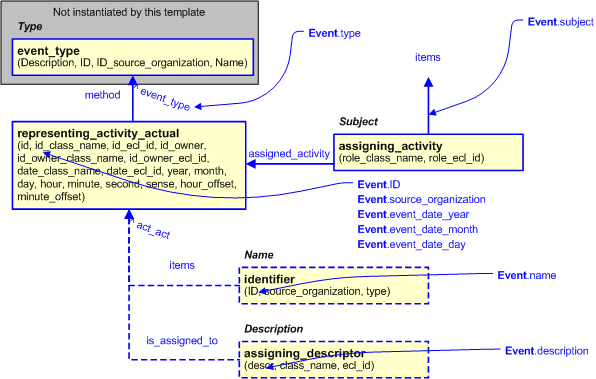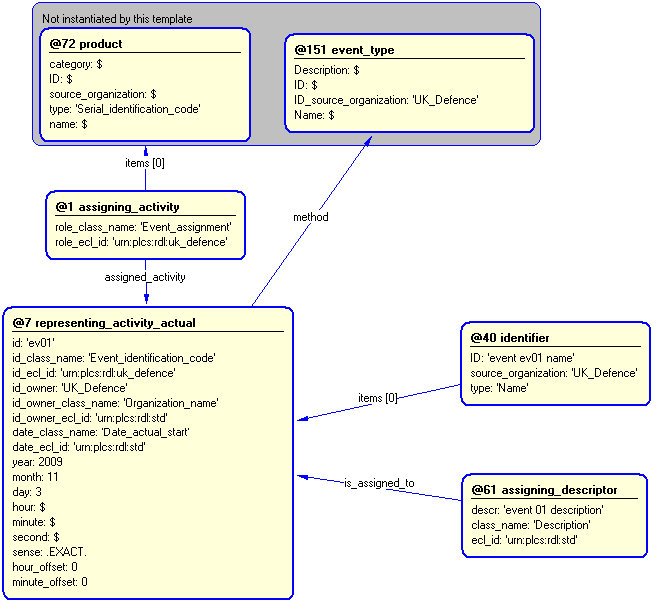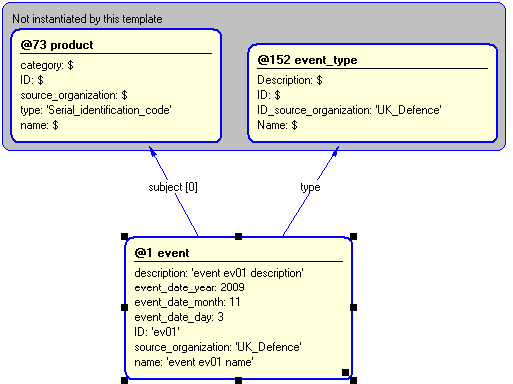Template:— event (evt)
Context:— UK_Defence |
Date: 2010/03/15 14:22:42
Revision: 1.6
|
This section specifies the template event.
NOTE
The template has been defined in the context of
UK_Defence.
Refer to the business context for details of related templates.
NOTE
An explanation of a template and the associated instantiation path is
provided in the
Template overview
section.
This template describes how to represent the UK_Defence concept of an event
in terms of PLCS model elements (templates, entities, and reference data).
This template describes how to represent UK_Defence event using
Activity_actual
This information object represents information about an
unexpected event, or happening, at a point in time.
Figure 1 — Graphical Representation for Business Object Event
Event
The definition of a Event object is:
This information object represents information about an unexpected event, or happening, at a point in time.
|
Attribute name
|
Attribute description
|
Attribute type
|
Optionality
|
| Description |
This is the description of the event. |
Intrinsic |
Optional |
| Event date |
This is the date and time at which the event occurred |
Intrinsic |
Mandatory |
| ID |
This is the identifier of the event. |
Identifier |
Mandatory |
| Name |
This is the name of the event |
Intrinsic |
Optional |
| Subject |
This is the reference to the item to which the event happens. Note: not mapped; see issue log |
Relationship to Product, Facility, Consignment or Utility |
Mandatory |
| Type |
This is the type of the event.
EXAMPLES:
"accident",
"foreign object damage"'
"air near miss"'
"incident"
|
Event type |
Mandatory |
Table 1 — Event attribute details
The EXPRESS-G diagram in
Figure
2
shows the templates and EXPRESS entities that are required
to represent the template
"event".
The text highlighted in blue shows the template parameters.
Figure 2 — An EXPRESS-G representation of the Information model for event
The graphic for the template to be used in other EXPRESS-G diagrams
is shown in Figure
3
below.
Figure 3 — The graphical representation of the event template
The following input parameters are defined for this template:
This is the description of the event.
The year portion of the date at which the event occurred
The month portion of the date at which the event occurred.
The day portion of the date at which the event occurred.
This is the identifier of the event.
The organization that created the associated identifier. Additionally
a Person or Information System could be defined when either of these are the source; see Identifier template characterizations
name (Type='STRING', Optional)
This is the name of the event.
This is the reference to the Product, Facility, Consignment or Utility.
The following reference parameters are defined for this template:
Allow the
Activity_actual
entity instantiated in this path to be referenced when this template is used.
%^target = $event.event%
The following parameter combinations specify a uniqueness constraint:
Unique constraint: Unique event
Each instance of the
entity
(
Activity_actual)
within the data set shall be uniquely identified
by a combination of the following parameters on this
template (event) namely:
ID,
subject.
The
instance is
referenced by the following template parameter:
event.
The instantiation path shown below specifies the entities that are to be
instantiated by the template.
A description of templates and the syntax for the instantiation path is
provided in the
Templates Help/Information section.
/
representing_activity_actual(
id=@ID,
id_class_name='Event_identification_code',
id_ecl_id='urn:plcs:rdl:uk_defence',
id_owner=@source_organization,
id_owner_class_name='Organization_name',
id_owner_ecl_id='urn:plcs:rdl:std',
date_class_name='Date_actual_start',
date_ecl_id='urn:plcs:rdl:std',
year=@event_date_year,
month=@event_date_month,
day=@event_date_day,
hour='',
minute='',
second='',
sense='.EXACT.',
hour_offset='0',
minute_offset='0',
method=@type)/
%^event = $representing_activity_actual.act_act%
-- [optional Name] /
identifier(
ID=@name,
source_organization=@source_organization,
type='Name',
items=^event)/
-- [optional Description] /
assigning_descriptor(
descr=@description,
class_name='Description',
ecl_id='urn:plcs:rdl:std',
is_assigned_to=^event)/
-- subject /
assigning_activity(
role_class_name='Event_assignment',
role_ecl_id='urn:plcs:rdl:uk_defence',
assigned_activity=^event,
items=@subject)/
The instance diagram in Figure
4
shows an example of the EXPRESS entities and templates that are instantiated by the template:
/event(description='event ev01 description', event_date_year='2009', event_date_month='11', event_date_day='3', ID='ev01', source_organization='UK_Defence', name='event ev01 name', subject='#s', type='#et')/
(an illustration of the consolidated event template is shown in
Figure
5 below.)
Figure 4 — Entities instantiated by event template
The instance diagram in
Figure
5
shows the graphic symbol for the template that is to be
used in other instance diagrams. The example template is:
/event(description='event ev01 description', event_date_year='2009', event_date_month='11', event_date_day='3', ID='ev01', source_organization='UK_Defence', name='event ev01 name', subject='#s', type='#et')/
Figure 5 — Instantiation of event template
Characterizations
No common characterizations of the template
event
have been identified. However, the ISO 10303-239 EXPRESS model
may enable other assignments to the entities instantiated by the template.




